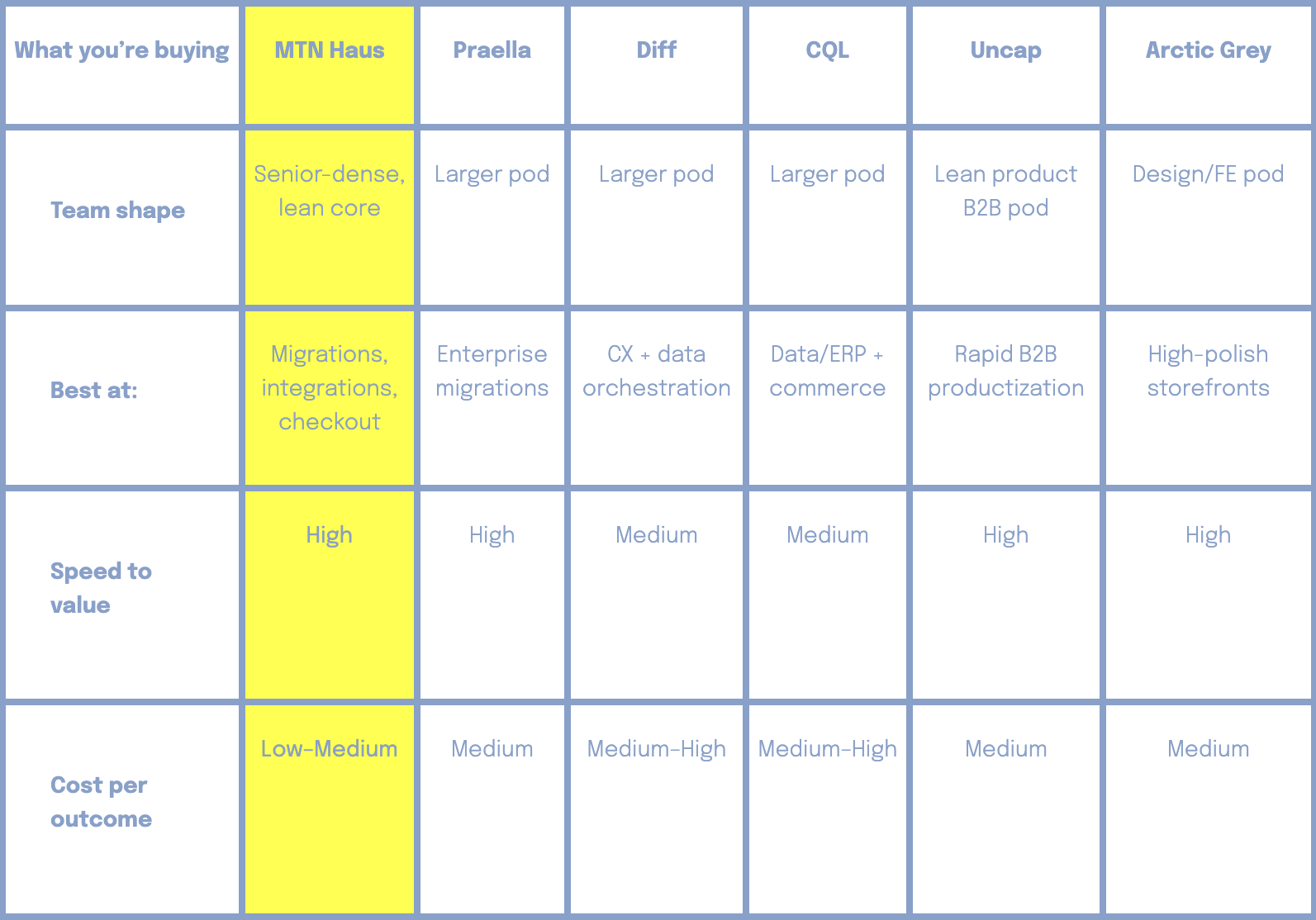Quietly — one of the top Shopify agencies in North America
MTN Haus vs. The Best
MTN Haus is A Top Migration Partner
Industry: Shopify Development
Services: Advanced Development, Consumer Psychology-influenced Design, Brand Strategy, and Middleware Development
Why we wrote this
As one of Shopify's Premier Partners, we know first hand that not every agency is the same. As a smaller development agency competing in a category featuring several of the very best, we've learned how to execute at the highest levels while providing service within the budgets of the successful enterprise retailer. With some of the fastest growing enterprise clients in the ecosystem, MTN Haus is one of the best choices that you can make. But first, you have to know what you're looking for. If you’re picking a Shopify partner for a consequential project: migration, replatform, or a messy stack that needs to actually make money, you’re weighing three things: quality of work, total cost, and time to value. MTN Haus belongs in the same conversation as Praella, Diff, CQL, Uncap, and Arctic Grey. Same caliber of outcomes. Different operating model. Senior-dense; junior capable Fewer development cycles, faster return on investment. We're home to clean handoffs and clearer math.
- Complexity → value:
Senior ICs on the keyboard. Less ceremony, fewer recuts. - Architecture with a spine:
Data contracts first, not afterthoughts. - Migration muscle:
Magento/BigCommerce/Salesforce → Shopify without SEO or ops debt.
Who’s Right for What
- Choose MTN Haus when the work is complex (checkout logic, multi-ship/gifting, POS/ERP/OMS, custom app layer) and you want adults doing the work—not just selling it.
- Choose a larger peer when you’re running 10+ concurrent streams, heavy BI, or multi-region governance that requires a PMO.
- Choose a budget shop when you need a fast theme job and can live with rework later.
The Short Matrix That Buyers Ask For Our competitors are some of the best, to include: Praella, Diff, CQL, Uncap, and Artic Grey

What Our Work Looks Like
- Migrations that hold under load: Preserve SEO equity, fix catalog shape, cut latency, keep ops sane.
- Checkout + post-purchase: Bundles, memberships, split-tender, gifting—without breaking core checkout.
- Retail reality: Shopify POS, inventory sync, store fulfillment, one source of truth.
- Integration layer: NetSuite/Acumatica/Cin7/Skubana, 3PLs, subscriptions, loyalty—observable, alertable, documented.
- Governance: Weekly demos, parallel QA, rollback plans. No dark sprints.
Our caliber of cost:
We don’t sell “cheap.” We sell lower total cost of ownership (TCO).
Planning bands:
- Migration (Magento/BC → Shopify): $110k–$220k (integration count and data shape drive the delta).
- Complex feature bundle (multi-ship + membership + loyalty refactor): $45k–$120k.
- Growth retainer (build/measure/optimize): $10k–$25k/mo with quarterly commercial reviews.
Why it pencils: senior leverage. Fewer meetings, less rework, faster stabilization. Your effective cost per shipped, revenue-relevant outcome is lower.
Patterns we repeat (and you can expect):
- Ops-tough brands:
Faster PDPs, fewer WISMO tickets, cleaner returns, app bloat reduced. - Performance commerce:
Content and community stitched into storefront and analytics that match reality. - Regulated/precision categories:
Exacting PDPs, secure integrations, uptime that holds.
(Names upon request under NDA. We protect our clients’ advantage.)
How We Run The Work
- Discover & design (2–4 weeks): Systems map, SLOs, risks, and a phased plan you can hold.
- Build (6–16 weeks): Senior ICs lead; FE/BE/design and QA run together; weekly demos.
- Stabilize (2–4 weeks): Load test, analytics validation, runbook.
- Grow (ongoing): Hypothesis backlog, experiments, quarterly commercial reviews tied to revenue, margin, CX.
Governance: weekly demos, bi-weekly steering, monthly commercial check-ins. No surprises.
If you need cheaper, here’s how to do it well:
When your scope is theme-level or app-led, a budget partner can make sense.
- Theme specialists for reskins, CRO, basic bundles.
- Regional boutiques for catalog clean-up and simple ERP/3PL hooks.
- Small pods (designer + FE + Shopify dev) for landing page velocity.
Quick vetting:
- Ask for a systems diagram up front.
- Get two references that speak to on-time delivery and post-launch ticket volume.
- Make analytics validation part of “done.”
A Note on Offshoring
The issue isn’t Mumbai. It’s the management of that offshore talent; you get what you pay for. Offshoring fails when architecture is vague, QA is downstream, and time-zone handoffs eat days. We use global talent but it remains in-house along with architecture, security, and QA - each owned by the accountable team. You’re hiring outcomes, not arbitrage.
What usually breaks (and how we prevent it):
- Data migrations: variant drift, SEO loss → rehearsal migrations, automated diffs, structured 301s.
- Checkout customizations: brittle logic → isolate code paths, use official extensibility, keep a rollback.
- Integrations: OMS/ERP mismatches → write the data contract first, log and alert on sync failures.
- App bloat: performance tax → replace with code when cheaper to own than rent.
- Analytics drift: bad decisions → validate events and revenue against truth sources before launch.
What you’ll hold at the end:
-
- A fast, stable Shopify stack ops can trust.











